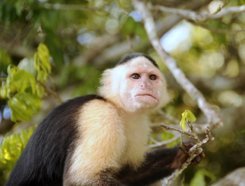
(San Diego Reader) Today, wedged between the old and the new, the natural and the modern, Panama is a country of both paradox and transition. With a biodiversity exceeding its more famous neighbor to the northwest – Costa Rica – and a natural landscape that varies from emerald rainforest to clouded mountains to marsh and bio-coastal oceans, the Panama experience is unique. This is Panama in the buff: a country steeped in natural grandeur, soulful elegance and naked beauty.
According to the Panamanian Minister of Tourism, Salo Shamah, “Panama is the best natural-kept secret in the world, with 40% of forests as protected areas and providing over 2% of the world’s oxygen.” Stripped bare, Panama is sanctuary to an insanity of wildlife and home to bosom-baring indigenous tribes embracing their cultural traditions and unique heritage.
Chagres National Park
Established in 1985 to protect the Chagres River basin and regulate Panama Canal watershed, the Chagres National Park also contains the historic Camino Real, a Spanish road once used to transport looted South American gold from Panama City to the Caribbean port of Portobelo.
Nowadays, the Chagres Basin provides not only all the drinking water for Panama City and Colón, it also provides the required 52 million gallons of water for each ship passing through the Panama Canal. Defined by difficult terrain and upland tropical forest, the Chagres National Park is also home to communities of the Emberá Indians.
The Emberá Parara Puru of Panama
The Emberá Parara Puru were a warrior culture originally from the remote rainforests of the Darien jungle, a densely dark stretch of almost impenetrable terrain located in the extreme east of Panama. Called the Darien Gap, it’s the only place where there is a break in the 30,000-mile stretch of the Pan-American Highway, and thus is the missing link for infrastructure connection of North, Central and South America.
Unfortunately, the region is also a magnet for modern-day pirates: guerrillas, drug traffickers, arms smugglers and people traffickers.
Because of this and difficulties in eking out even a sub-standard existence, a small tribe of Emberá relocated to the Chagres National Park over a decade ago. Their chief, Antonio Tocamo, proposed an ecotourism initiative to establish a demonstrative village to preserve their culture and traditions in a sustainable fashion while sharing their heritage with the outside world. It is because of this foresight and vision that the Emberá now welcome visitors for a glimpse into their vanishing world.
The men wear traditional loincloths and the women go topless, though the younger ones are now adopting Western ways by wearing jewelry or beaded bra-like garments that conceal their breasts. After ceremonial dancing, they offer temporary tattoos made from the jagua fruit (it wears off in about 10 days) and beautiful wood carvings depicting jungle animals for sale along with intricate baskets that geometrically capture the flora and fauna of the region.
The ecotourism venture includes a typical lunch of fried fish wrapped and served in banana leaves accompanied by an assortment of native tropical fruits. The income they receive from the sale of their carvings and baskets allows them to retain their heritage in a sustainable way.
Gamboa Rainforest Resort, Capuchin Monkeys and So Much More
Less than an hour drive from bustling Panama City, you effortlessly transition from international financial capital to the Panama Canal watershed. Verdant rainforests hug the banks of the Chagres River and Panama Canal.
Here lies the Gamboa Rainforest Resort, located in the Soberania National Park rainforest and home to secretive islands harboring white-headed capuchin and clamoring howler monkeys, an incredible diversity of migratory birds (over 650 bird species), color-saturated tropical frogs and the uncommon slow-moving two-toed sloths – along with more common alligators, turtles and even slower-moving three-toed sloths.
A half-day excursion to Monkey Island takes you through the Panama Canal while searching for the hideaway habitats of primates. The white-headed capuchins – a New World monkey found from Central America to the northern limits of Argentina – are considered the most intelligent (and arguably the most adorable).
Named after an offshoot of Franciscan friars who wore trademark brown robes with cavernous cowls, the white-headed capuchins are distinct, with black skull caps offsetting pink faces and white fur around the face, neck and shoulders. And because of a prehensile tail as long as their body, they gleefully sport an acrobatic agility in their diurnal search for fruits, nuts, seeds, crabs and shellfish. A morning or afternoon excursion to witness these amusing primates in action is an unforgettable encounter with the wild side of Panama.
Modern Marvel: Panama Canal
With the construction and completion of the Panama Canal in 1914, Panama landed on the world’s center stage and secured its permanent place in history. The Panama Canal also cemented Panama’s preeminent role in today’s world of shipping and commerce. Considered to be one of the greatest engineering feats in the world, the shortcut shipping lane between the Atlantic and Pacific Oceans is iconic in capturing a balance of economy and ecology – a constructive coexistence with nature.
The best way to experience the canal, short of an expensive ship cruise itinerary, is to book partial canal transit. According to Robert Schnack, longtime Panama Canal pilot, the partial transit of the locks on a down lockage is a memorable event. “There are more photo ops going down than up, and the background is more scenic,” says Schnack. “You can see more and it is a marquee for the rest of the trip.”
Panama in the Buff
Whether it’s the tranquility of the tropics, the serenades of hidden jungle wildlife, a glimpse into the lives of bare-breasted exotic Embera Indians or the engineering grandeur of linking two great oceans through one small land sliver, Panama is most beautiful when experienced in the buff – in the raw.
This is when the country bares its soul and naked beauty to those searching for the essence of the Panama experience.
By Karin Leperi